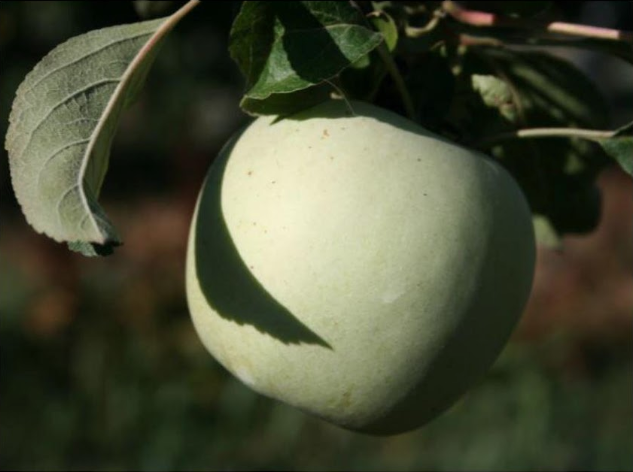Crop: Malus domestica Borkh (Apple)
The tree is characterised by high vigour and upright tree habit. Flowers are grouped in corymbs carrying five flowers each; on average the corolla is 38mm and petals are oval shaped. Before anthesis, flowers are red. During the anthesis petals are overlapping one to another and the stigma is clearly placed above the anthers.
On average leaves are 87 mm long and 57 mm wide.
Fruits are medium size (circa 160 g), characterised by and conic shape. The skin is smooth and ground-colour is greenish-yellow while the over-colour is light pink. Fruit surface russetted is low. The pulp is white and the fruit texture intermediate.
Flowering occurs in April, with a peak between the 10th and 20th. The harvest is generally carried out in October. Fruits are generally characterised by good storability.
Cultivation System: conventional conditions
Geographical Information
Country: Italy
‘Mela Conventina’ was traditionally cultivated within the municipality of Gubbio (Perugia, Italy). The landrace could also be found in other municipalities of the same province (Perugia): Gualdo Tadino, Pietralunga, Scheggia, Valfabbrica and Perugia in their hilly areas. Currently, its cultivation is carried out by a single farmer in the Province of Perugia.
Farmer(s) description:
Currently, few plants are conserved on-farm. Typically, plants are conserved within different farms and small private orchards only for family consumption. In recent years, a local farmer planted a new apple orchard using ‘Mela Conventina’. Such farm is specialized in apple production and used to cultivate only modern varieties.
Propagation system: Clonal
Multiplication procedures and consequences on landrace diversity:As other apple varieties, this landrace is propagated by grafting onto rootstocks. The propagation activity is mainly carried out by the Foundation named ‘Archeologia Arborea’ (San Lorenzo – Lerchi, Perugia, Italy). Recently, an intense vegetative propagation of this landrace was carried out in order to produce hundreds of individuals as a local apple producer planted an apple orchard using this landrace.
The use of grafting starting from very few individuals causes reduction of the within population genetic diversity. Anyhow, the vigour of the grafted plants together with their adaptability to different soils can be managed through selection of proper rootstocks.
Management plan existence:The landrace management relies completely on farming activities in the area. Currently, no technical or scientific support is given.
Added Values
Currently, no local or national market exists as the production of ‘Mela Conventina’ is carried out by few farmers/gardeners, conserving few individuals. By the way, in the next few years the market of ‘Mela Conventina’ will have the possibility to grow as a local apple producer recently planted an orchard using this landrace.
Others (e.g. commercial/geographical brands or special traits):In 2013 ‘Mela Conventina’ was included into the Regional Register of Landraces (Umbria Region, Italy), implementing the Umbria Region Law concerning the protection of local genetic resources (n. 25, 2001). Fruits of Mela Conventina are characterised by good storability.
‘Mela Conventina’ was rescued within a project funded by the Province of Perugia through a plan of valorisation of agro-biodiversity (within the the EU’s Rural Development Plan 2000-2006). Within this framework the University of Perugia gave technical and scientific support.
Currently, ‘Mela Conventina’ is conserved in four different ex situ collections: i) Within the fruit tree collection of 3A-PTA in Todi (Perugia Italy) and ii) in vitro at the germplasm bank held by the same institution; iiI) within the tree collection belonging to ‘Fondazione per l’Istruzione Agraria’ in Deruta (Perugia, Italy) and iv) it is also conserved in the tree collection belonging to the Foundation named ‘Archeologia Arborea’ (San Lorenzo – Lerchi, Perugia, Italy).
Provisions set by the local organisations aimed at characterising and saving the landrace. Further activities are needed to enhance on-farm conservation and to increase the use of such resource. However, a local farmer planted a new apple orchard using the landrace, giving hope to further future activities related to this landrace.
Uncertain. To have access to the resource ‘Regione Umbria’ (http://www.regione.umbria.it/agricoltura) or
‘3A-PTA’ (http://www.parco3a.org/pagine/contatti-004) should be contacted.
Most of updates have been retrieved from 3A-PTA website (http://biodiversita.umbria.parco3a.org/schede/mela-conventina).
Information were also communicated by Dr I. Dalla Ragione (Fondazione Archeologia Arborea).
ND.
